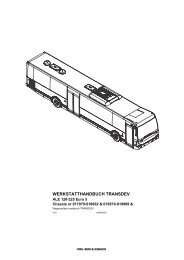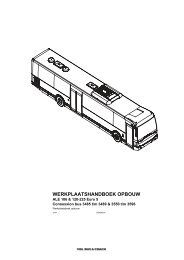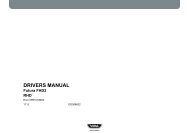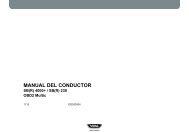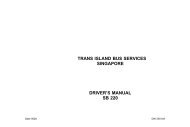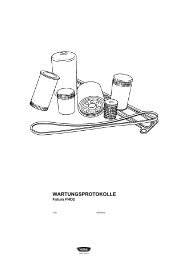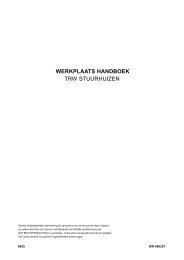manuel de conduite et d'entretien sb 220 gs - Training Registration ...
manuel de conduite et d'entretien sb 220 gs - Training Registration ...
manuel de conduite et d'entretien sb 220 gs - Training Registration ...
Create successful ePaper yourself
Turn your PDF publications into a flip-book with our unique Google optimized e-Paper software.
SPECIFICATIONS LIQUIDES DE REFROIDISSEMENT<br />
Le liqui<strong>de</strong> <strong>de</strong> refroidissement est un produit nocif.<br />
Protéger la peau <strong>et</strong> les yeux.<br />
Le liqui<strong>de</strong> <strong>de</strong> refroidissement est nocif pour<br />
l’environnement <strong>et</strong> doit être traité comme déch<strong>et</strong><br />
industriel.<br />
Remplir <strong>de</strong> préférence le système <strong>de</strong> refroidissement avec un<br />
liqui<strong>de</strong> <strong>de</strong> refroidissement prêt à l’emploi où les agents antigel <strong>et</strong><br />
anti-corrosion sont déjà intégrés. En cas d’utilisation d’eau <strong>de</strong><br />
ville <strong>et</strong> si les températures sont inférieures à +5°C, ajouter une<br />
solution antigel à base d’éthylène-glycol ou <strong>de</strong> propylène-glycol +<br />
<strong>de</strong>s additifs anti-corrosion.<br />
- Pour une protection jusqu’à -18°C, ajouter 33% d’agent antigel.<br />
- Pour une protection jusqu’à -37°C, ajouter 50% d’agent antigel.<br />
Le LIQUIDE DE REFROIDISSEMENT <strong>et</strong> l’AGENT ANTI-CORROSION<br />
doivent satisfaire à la norme:<br />
éthylene-glycol: ASTM D-3306, BS 6580 <strong>et</strong> SAE-J-1034.<br />
propylène-glycol: ASTM D-5216 <strong>et</strong> BS 6580.<br />
L’éthylène-glycol <strong>et</strong> le propylène-glycol ne doivent jamais être<br />
mélangés car les additifs ne sont pas compatibles. Il est aussi<br />
recommandé <strong>de</strong> ne pas mélanger un type <strong>de</strong> glycol <strong>de</strong> diverses<br />
marques.<br />
En production, les véhicules reçoivent l’agent <strong>de</strong> refroidissement<br />
DOW 007/400F. Le mélange eau-antigel peut rester dans le système<br />
pendant les mois d’été. Dans ce cas également, il convient <strong>de</strong> tenir<br />
à niveau la concentration d’antigel <strong>et</strong> donc la protection contre la<br />
corrosion entre autres.<br />
Lorsque les températures ne <strong>de</strong>scen<strong>de</strong>nt jamais sous les +5°C, il<br />
suffit d’ajouter un agent anti-corrosion à l’eau <strong>de</strong> refroidissement<br />
conformément à ASTM D-3306.<br />
Voir les prescriptions du fabricant.<br />
CRITERES DE QUALITE DE L’EAU DE REFROIDISSEMENT<br />
- pH 5,5 - 9,0<br />
- teneur totale en<br />
particules soli<strong>de</strong>s ≤ 340 ppm<br />
- dur<strong>et</strong>é ≤ 170 ppm (carbonate <strong>de</strong> calcium <strong>et</strong>/ ou<br />
<strong>de</strong> magnésium)<br />
- chlorure ≤ 40 ppm (chlorure <strong>de</strong> sodium)<br />
- sulfate ≤ 100 ppm (sulate <strong>de</strong> magnésium <strong>et</strong>/<br />
ou <strong>de</strong> sodium)<br />
Rincer le système <strong>de</strong> refroidissement tous les <strong>de</strong>ux ans <strong>et</strong><br />
renouveler à c<strong>et</strong>te occasion le liqui<strong>de</strong> <strong>de</strong> refroidissement.<br />
Les données mentionnées ci-<strong>de</strong>ssus sont basées sur <strong>de</strong>s conditions<br />
d’utilisation normales du véhicule. Les produits mentionnés ci-avant<br />
étant vendus dans le commerce sous <strong>de</strong>s appellations différentes,<br />
il est recommandé <strong>de</strong> vous adresser à votre fournisseur habituel <strong>de</strong><br />
lubrifiants, <strong>de</strong> carburant <strong>et</strong> <strong>de</strong> liqui<strong>de</strong> <strong>de</strong> refroidissement pour obtenir<br />
l’interprétation correcte <strong>de</strong> ces spécifications.<br />
CARACTERISTIQUES TECHNIQUES<br />
81



